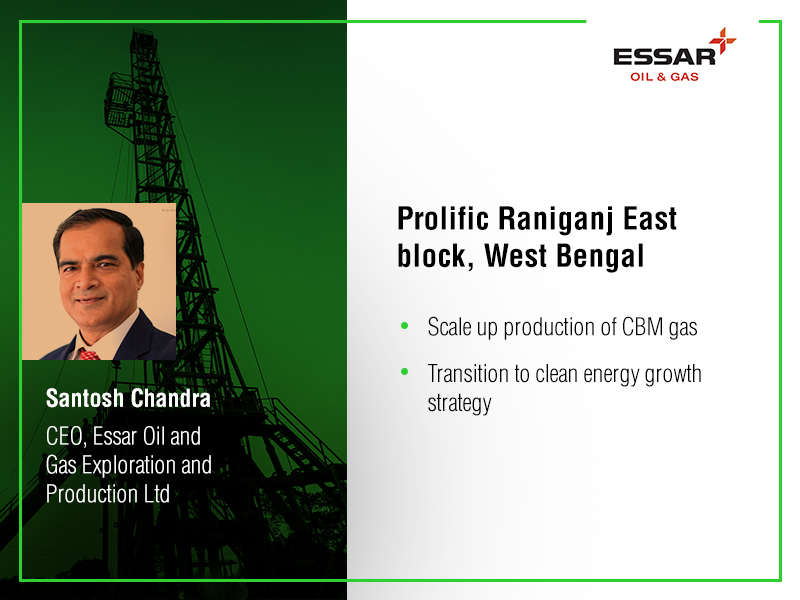EOGEPL has ambitious plans to scale up the Raniganj block’s CBM production to 3 million cubic metres per day over the next couple of years, buoyed by its recent access to a main grid gas pipeline.

When Santosh Chandra reminisces about his childhood he thinks of climbing trees, playing in the sand and flying kites on the beach in Andaman and Nicobar Islands, the exotic archipelago in the Bay of Bengal.
Chandra, chief executive of India’s Essar Oil & Gas Exploration & Production (EOGEPL), says his fondness for nature began early.
“When you’re connected to nature, you value the nature you see,” he says.
That connection makes the burgeoning debate on climate change quite close to Chandra’s heart.
“When this climate change thing is coming up, you know, whether it is on deforestation or other things, you really appreciate those because nature can be very beautiful and pristine,” he says.
As chief executive, Chandra is spearheading EOGEPL’s coalbed methane business.
He is adamant that production of the unconventional gas, generated from beneath coal seams, can be far cleaner and less carbon-intensive than conventional natural gas.
EOGPL operates the Raniganj East block in the Indian state of West Bengal and the company is currently the largest producer of CBM in the country, with daily production exceeding 800,000 cubic metres per day, he says.
Chandra says producing gas from a CBM block has been an arduous process that has lacked government support in the past, but he remains hopeful that the industry is now poised for exponential growth.
He is positioning Essar to capitalise on that growth, with the company preparing to kick-start a drilling campaign early next year involving 200 to 250 wells.
Scaling up
Chandra says the company has ambitious plans to scale up the Raniganj block’s CBM production to 3 million cubic metres per day over the next couple of years, buoyed by its recent access to a main grid gas pipeline.
When he joined Essar last year, during the peak of the pandemic, the company was facing a serious gas offtake issue in the absence of a viable consumer base in the region.
Chandra helped orchestrate a turnaround for the company and the block is now connected to the Ganga Urja grid gas pipeline, massively improving its offtake fundamentals.
An industry veteran who has spent more than three decades in oil and gas, Chandra has worked with industry stalwarts Cairn Oil & Gas, Tullow Oil and stateowned Oil & Natural Gas Corporation (ONGC).
He graduated in petroleum engineering from the reputed Indian School of Mines, Dhanbad, and joined ONGC in 1998 as a reservoir engineer fresh out of college.
His initial days with ONGC were spent doing onshore exploratory drilling, mostly in the Southern part of the country.
Chandra describes his early days with the Indian giant, making up pipes and working on the rig floor, as a learning process that laid the foundation for his long haul in the oil and gas sector.
A transformation came in 1995, when Chandra joined privatesector player Command Petroleum at the outset of the liberalisation of India’s oil and gas sector.
Joining Command was a tough call for him and his family, as the company was nearly a start-up. But it would prove to be a resounding success later with its Ravva offshore operations.
Command was acquired by Cairn Energy and Chandra spent close to two decades with Cairn, witnessing the company’s surge from a $200 million market cap to $14 billion by 2011, when it was sold to Vedanta Resources.
During his days at Cairn, Chandra was quite closely involved with three landmark discoveries: a deep-water discovery in the prolific KG-DWN- 98/2 block, now operated by ONGC; the Rajasthan onshore oil discovery; and the Hazira find.
Transition
In 2013, Chandra moved on from Cairn to join independent Tullow Oil, working across its Africa and UK operations.
Having seen multiple boom and bust cycles over the decades, Chandra agrees that the industry is now transitioning towards cleaner fuels and expects the pace to further pick up in coming years.
However, he believes that oil and gas will continue to be integral to the energy basket for the next three to four decades, at least.
Oil and gas companies can be resilient by keeping their cost structures low, innovating on technology and maintaining continuous dialogue with governments involved, as they brace for the fast-paced energy transition, he says.
Chandra was born in Agra in the Indian state of Uttar Pradesh, but most of his formative years were spent on the Andaman and Nicobar Islands, where his father worked as a teacher.
His were humble beginnings, considering his father had to take care of six children in the family, making ends meet in every possible way.
Chandra developed an early interest in golf and ended up winning many club tournaments, but over the years he turned to hiking, a passion that has endured.
While in Uganda in 2019, Chandra and his family climbed famous Mount Kilimanjaro, Africa’s highest peak, which Chandra describes as an exhilarating experience that involved a seven-day trek and temperatures that fell below minus 10 degrees Celsius on a few occasions.
The expedition was a “tough one” but Chandra draws lessons for life from his mountaineering experiences: in life, as in hiking, he says, it is crucial to set a target, prepare yourself, and then slowly and steadily take the small steps towards your destination.
Source: upstream